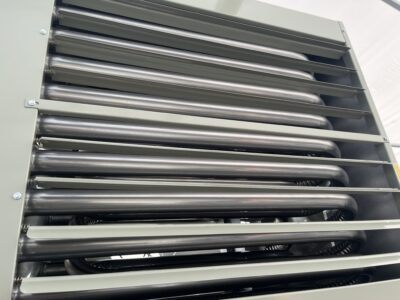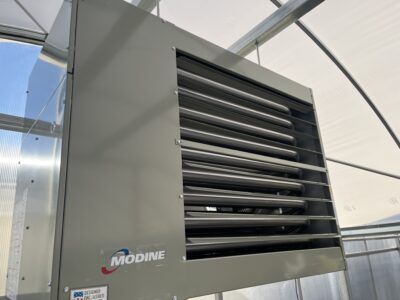
By Keith Bemerer and Jared Freyer
It is that time of year when leaves change color and fall on the ground, greenhouse vents stay closed, and a freeze warning hits your area. After months of natural and forced ventilation, it is time to do the opposite and tighten up the greenhouses, close everything open to the outside, and kick on the greenhouse heaters.
Overhead Greenhouse Heaters Then and Now
Greenhouse heating is no longer a simple thing. In the early 1900s, coal-fired stoker boilers heated many wooden A-Frame houses comfortably for decades. An environmental push switched out many of those to hot-water and steam boilers in the 1970s. These heaters worked great for keeping greenhouses warm and helping to melt snow off the gutters, but a more localized heat source was needed, especially for ground-to-ground structures. As a result, unit heaters have become one of the most common greenhouse heating devices used today.
The efficiency of unit greenhouse heaters has changed dramatically in the last 30 years. Many original heaters were standing pilot, meaning a constant flame ignited the heater when the greenhouse required heat. Standing pilot heaters proved inefficient with less than 80% thermal efficiency. Plus, they heightened the risk of starting a fire.
Later, intermittent systems replaced the standing pilots. These systems ignited with a spark and included a giant fan on the back to push warm air into the greenhouse.

Bent tube heaters represent a newer style of low-profile greenhouse heaters that direct the flame through a tube and then a fan pushes the heat from the tube into the greenhouse.
This method increases the thermal efficiency of bent tube heaters from 83% to 87%, placing them into what we know now as the standard efficiency class. With electronic controls and protections against thermal overload and misfires, bent tube heaters stand as a popular choice among growers for use in the greenhouse environment.
Power-Exhausted Versus Separated-Combustion Greenhouse Heaters
Standard efficiency heaters fall into two categories — power exhausted and separated combustion.
Power-exhausted heaters feature only a single flue vent and operate more simply, compared to separated-combustion heaters, by pulling combustion air from within the greenhouse and exhausting it through a flue vent outdoors. However, this can create a slight negative pressure on the greenhouse.
Separated-combustion heaters have two vents, one for combustion air intake and one for exhaust. They pull in air from outdoors and exhaust it back to the outdoors. This creates neutral air pressure within the greenhouse.

Heating with High Efficiency
With energy efficiency the talk of the town, many states and cities have started to require higher-efficiency heating systems. The call for 92% to 97% efficiency is not uncommon, and the technology is now available.
These greenhouse heaters fall into the high-efficiency class. They have a condensing system with separated combustion and a larger tube surface area compared to their standard efficiency counterparts. The extra tube surface area allows for the exhaust gases to cool further and extract more heat into the greenhouse.
The process creates another by-product — condensation — that needs to be piped out and away from the heater. Be careful, however, as condensation lines piped to the outside can freeze, causing more issues.
Many states allow for tax breaks on this style of heaters. If your state extends this opportunity, the cost offset makes it worthwhile and offers you more peace of mind in efficiency.
Key Factors and Calculations for Proper Sizing
When selecting a heater, you need one properly sized for your greenhouse. Prospiant can help ensure you have the right size by calculating your heat load for you.
Keep in mind four important pieces of information when making your selection:
- Delta T: The difference between your desired target indoor temperature and your lowest outdoor temperature defines your Delta T. The heat loss load in BTUs correlates proportionately to the Delta T.
- Greenhouse size: Specifically, the important measurements include the length, width, gutter height, and gable height. You need these measurements to calculate your overall volume for air exchanges (assume 1.0 ACH in winter) and overall surface area for your heat loss via convection.
- Glazing material: Each type of glazing material has a convection heat loss value, also known as a U-value. This value tells you how much heat loss occurs across that material per square foot per °F Delta T.
- Heat retention curtain: If you use a heat retention curtain to retain heat at night, you can take credit for this heat retention value against whatever surface it is installed against.
Inspect Before You Heat
Finally, do your due diligence and check your existing heaters before you start them up after a long period of sitting idle. Birds especially like to make nests inside the heaters and pull away insulation around the exchanger. Insects like the Mud Dauber will cake dirt and other debris into the jets and cause misfires. Spiders contribute nests and webs. You want to address these types of issues before you fire up your heaters.
Also, make sure you have enough clearance surrounding your heater. This not only prevents fire hazards and provides working clearance, but also allows the heater to pull in air.
Check your greenhouse heaters in the fall, along with thermostats, to confirm they work properly. You’ll save yourself the inconvenience of having late-night issues with a failing heater.
A cracked exchanger indicates you need to replace your failed heater. Cracked exchangers not only allow gasses to escape, but also can cause growth issues with your winter and spring crops.
Whatever your heating needs, remember that Prospiant sells many brands of unit heaters and their parts. We can help you keep that level of commitment to making your greenhouse run smoothly and efficiently any time of the year.
Our experts can quickly help you select the right greenhouse heater for your growing needs. Contact us at [email protected]
Need Some Inspiration?
Browse through our diverse range of building projects. Click on the links below to see some of the great greenhouse projects we have worked on.
Be the first to write a comment.